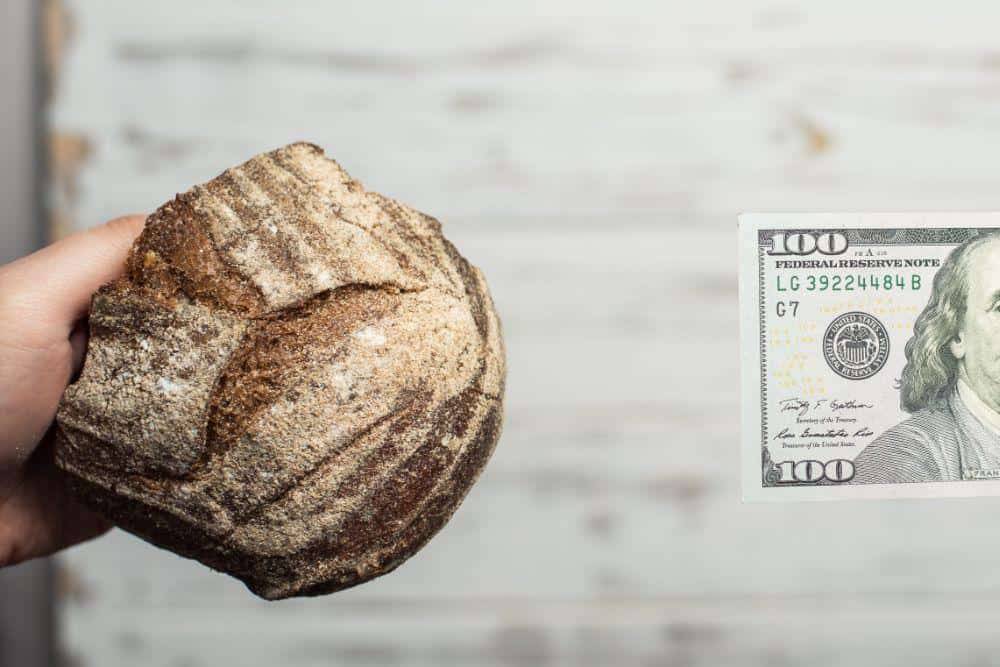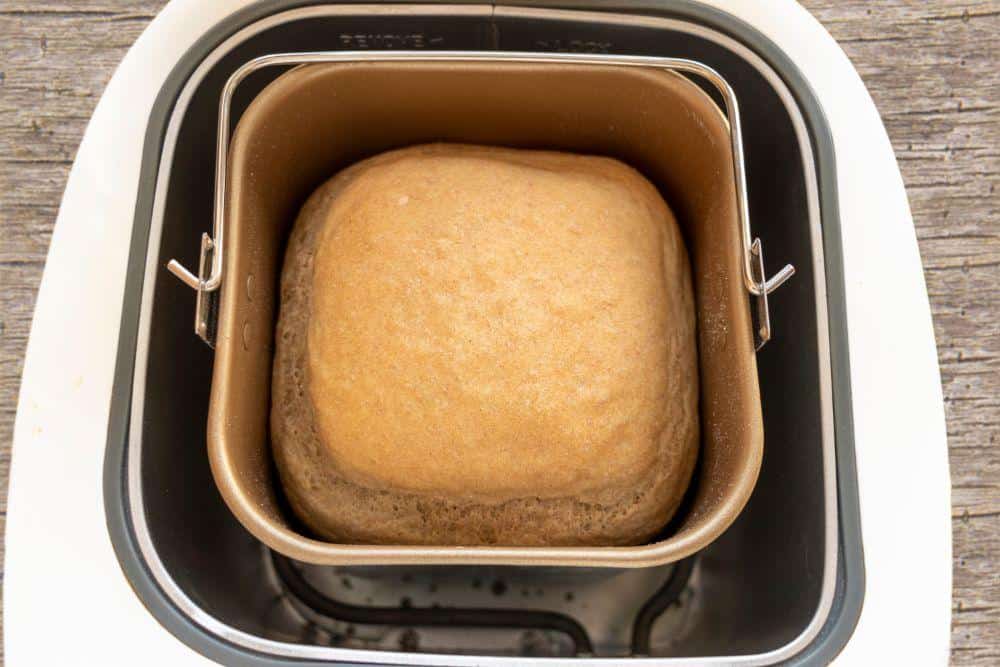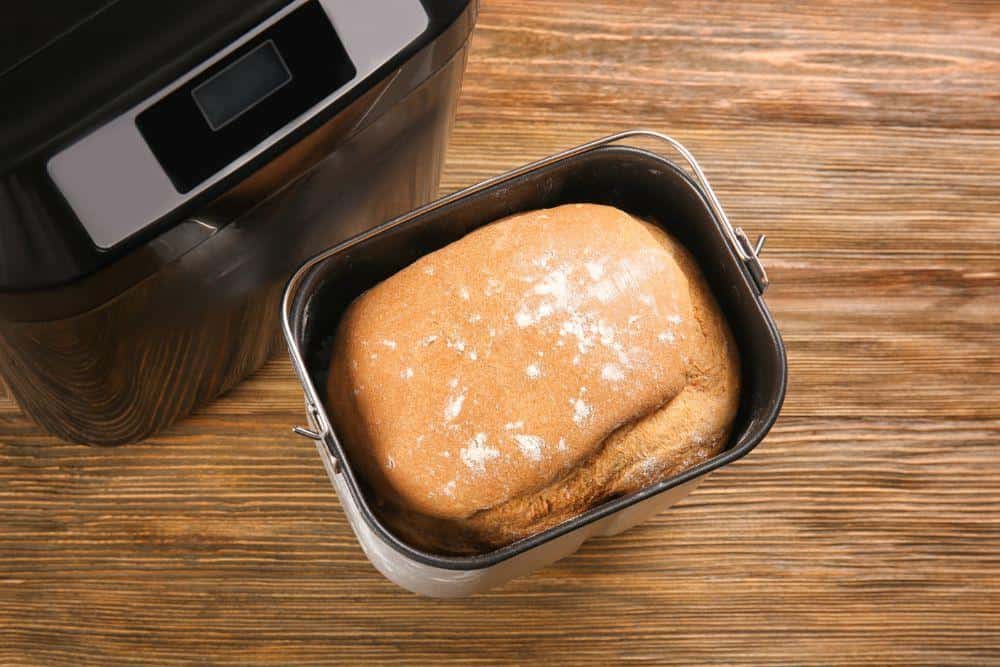With rising food costs due to inflation, people make more food at home rather than purchasing store-bought alternatives. Let’s talk about bread! While it is easy to grab a loaf during a grocery trip, it can be more rewarding to make homemade bread for many reasons.

Does it Make Economic Sense to Bake Bread as Opposed to Buying from the Grocery Store?
Can you save money by making bread instead of buying store bought bread? Absolutely! While it may cost more than store-brand bread to make, it costs less than a name-brand loaf of bread. Plus, you will have delicious-tasting bread without preservatives that you can be proud you made yourself!
Bread makers range in wattage from 450 watts to 1,500 watts. Burning fewer watts of electricity means you are reducing your carbon footprint.
Since a bread maker outputs low kilowatt-hours (kWh), it is a great alternative to use this machine rather than the oven. Sometimes you can use less than 1 kWh when using a bread machine which is super low cost.
You can convert watts into Kwh by using a simple formula. Completing this formula will help you to discover how much electricity your bread maker burns while making homemade bread.
kWh= (watts x hours) / 1,000
If you have a bread machine that uses 1,500 watts in power while operating, you will have a low kWh rating. Most bread recipes take about 30-40 minutes to bake, so the bread maker will not be burning electricity for long
Here is a simple calculation of converting a 1,500-watt bread machine into the amount of kWh. 0.5 hours will be used for the number of hours as an average because 30 minutes is half a total of 60 minutes (one hour).
kWh= (1,500 x 0.5 hours) / 1,000
kWh= 750 / 1,000
kWh= 0.75
Depending on the wattage output of your bread maker, you can calculate the amount of kWh that it burns using this formula. This is an important element in discovering the answer to the question: Can you save money by making bread instead of buying it?
Making homemade bread takes some time, but it is well worth the wait. Combine the ingredients including vegetable oil, flour, salt, sugar, active dry yeast, and water into a mixing bowl.
Knead the bread dough until everything is combined. Place the dough into a bowl and cover it with a damp dish towel or plastic wrap. 
Fully Baked Bread in a Bread Machine
Allow at least one hour for the active dry yeast to help the bread rise. You can allow the bread to be set for one to two hours long so it can be more fluffy.
Once the bread has fully risen, preheat your bread maker or oven to about 350 degrees Fahrenheit. Bake the bread for about 20-40 minutes, depending on the time the recipe you follow instructs you.
Let’s talk about calculations of homemade bread. Since homemade bread ingredients include water (free), sugar, active dry yeast, vegetable oil, salt, and flour, we will discuss the average cost of the amount of each ingredient that you are using when making an average recipe for homemade bread.
A four-pound bag of store-brand sugar at Walmart is $2.33. This bag equates to about 9 cups of sugar. Hence, each cup of sugar costs 26 cents.
An average bread recipe calls for about a half cup of sugar. Hence, you will only be spending about 13 cents on this ingredient.
As I write this, a three-pack of Fleischmann’s active dry yeast is $1.47 at Walmart. The average bread recipe calls for about 1.5 tablespoons - each packet has about 2.25 teaspoons per packet. This is a total of 6.75 tablespoons in all three packets. It takes 3 teaspoons to make a tablespoon which means you can bake about 2 loaves of bread with this product. Hence, if you are using only half of the active dry yeast to make one loaf of bread, you will only be spending 73 cents.
A five-pound bag of Great Value all-purpose flour is $1.76 - this equates to about 18 cups of flour. That is 9.7 cents per cup of flour.
The average bread recipe calls for 5-6 cups of all-purpose flour (you can alternatively use bread flour). Let’s say that you will use 5 cups of flour to make your homemade bread. It will cost about 48 cents.
Store brand salt at Walmart costs 40 cents for 26 ounces. You need about 1.5 teaspoons of salt to make homemade bread. There are 156 teaspoons in 26 ounces of salt. This equates to 1.5 cents per teaspoon. Hence, using 1.5 teaspoons of salt in your recipe will cost you 2.25 cents.
A 48-ounce bottle of store-brand vegetable oil from Walmart is $3.12 which equates to 6.5 cents per ounce or 52 cents per cup. You only need about a ¼ cup of vegetable oil which equals 13 cents of the ingredient for this recipe.
Here is the total cost of homemade bread based on the breakdown we have analyzed. The flour and salt have been rounded down for sake of easier calculation.
Water: Free
Sugar: $0.13
Active dry yeast: $0.73
Flour: $0.48
Salt: $0.02
Vegetable oil: $0.13
Total for Ingredients: $1.49
Let’s also calculate the average electricity you will burn if you are making bread in a bread machine. We mentioned that you are using about 0.75 kWh when baking bread for 30 minutes in a 1,500-watt bread maker.
According to the U.S. Energy Information Administration, the average cost of electricity per kWh is 10.59 cents. Below is a calculation of electricity cost based on this average.
0.1059 cents per kWh x 0.75 kWh= 0.079
Hence, you are only spending eight cents to make a homemade loaf of bread using a bread machine. You are only spending about $1.57 to make your loaf of bread.
Store brand bread costs about $1 per loaf while brand name loaves range from $2.50 to $4 depending on the designated price point of the said brand of the bread type. When you usually purchase name-brand varieties, you can save money by taking the time to make bread at home.

A Completed Loaf of Bread Ready to be Removed From the Bread Pan
While you will have to spend more money to make homemade bread versus purchasing store brands, you can benefit from making bread at home if you usually purchase name brands. It is all up to your preference in taste and desired cost output.
If you know what you're doing, Fresh baked bread is usually better than store bought because there are no extra preservatives. Store-bought bread is laden with preservatives to help the bread have a longer shelf life.
The Food and Drug Administration states that preservatives help foods keep the same flavor and slow the mold developing process. However, benzoic, propionic, and sorbic acids used to preserve store-bought bread can eventually lead to hyperactivity, asthma, different allergies, and even cancer.
From a health standpoint, homemade bread is better than store-bought. It can be just as tasty if not tastier than its store-bought cousin.
Of course you can also make a variety of breads when you make bread at home. Bread machines actually have settings for almost any bread you can think of. These breadmakers can make staples like white bread, wheat bread, dinner rolls and homemade sourdough bread but you aren't even limited to bread. Many breadmakers can even make pizza dough, jams, and even yogurt!
Baking bread is cheaper than buying it only if you usually purchase name-brand bread. Since you will be spending about 50 cents more to make bread at home than grabbing store-brand bread (average $1 per loaf), you may want to save money by continuing to buy your favorite store-brand bread.
If you purchase name-brand bread that can be upwards of $3 to $4 per loaf, you will be saving considerable money on your grocery bill by making it at home. You can save about $1.50 to $2.50 per loaf by making bread at home if you purchase name-brand varieties.
There are other costs involved when it comes to involving making your own sourdough bread versus going to the bakery and bringing home packaged bread with the rest of your groceries.
Bread making at home does take time. The time involved isn't insignificant. You'll have to prep the ingredients, bake the bread and of course clean up your bread pan and mixing bowl once the process is over. This may make making bread a bit more time intensive at home as opposed to picking up bread from the baked goods section at your local supermarket.
Since homemade bread does not have preservatives, it will only last about three to four days. Store-bought bread usually lasts 5-7 days after you first open the loaf.
Error on the side of caution and use your homemade bread within three days for optimal fresh bread. Since you'll have less time to actually consume the bread, you'll want to make just the right amount to avoid having stale bread.
If you accidentally leave out the bread from its airtight container or if it forms mold after the recommended storage period, discard it immediately. Food waste is another obvious concern with homeeade bread due to its relatively short shelf life.
Store your homemade bread in an airtight container. It will keep the loaf fluffy and delicious by cutting off the air circulation. If you fail to store it in an airtight container, your bread can dry out just within hours of sitting out.
Making homemade bread does not take long at all. You may only need five minutes to gather the ingredients and measure them out to mix in a bowl. At a minimum, you need one hour to let the bread rise. Bake the bread for at least 30 minutes for optimal taste and quality. Hence, you are only spending about one hour and 35 minutes making a loaf of bread at home.
If you have children at home, you can include them in the activity for a wonderful life learning experience. Help in the kitchen helps tasks to get finished more quickly.
It is worth purchasing a bread machine if you regularly make homemade bread. Doing so can:
So can you save money by making bread instead of buying it? As we discussed before, baking a loaf of bread in a bread machine only costs about eight cents. Gas is usually a more cost-effective cooking method than electricity. However, because of the low electrical output of the bread maker, the few extra cents it takes to make the bread in that machine is not a huge difference from baking it in the oven.
